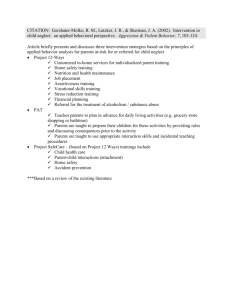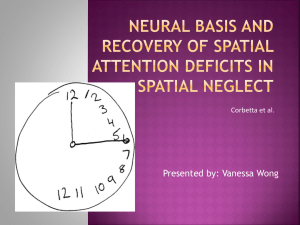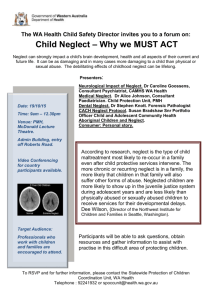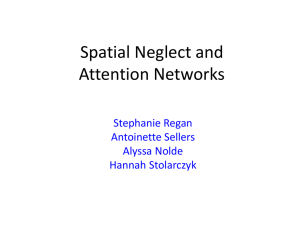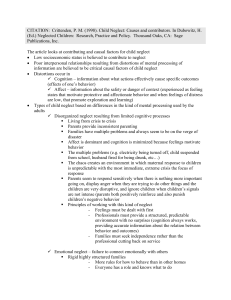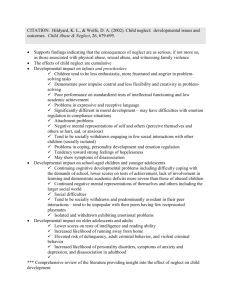21 June 2001
advertisement
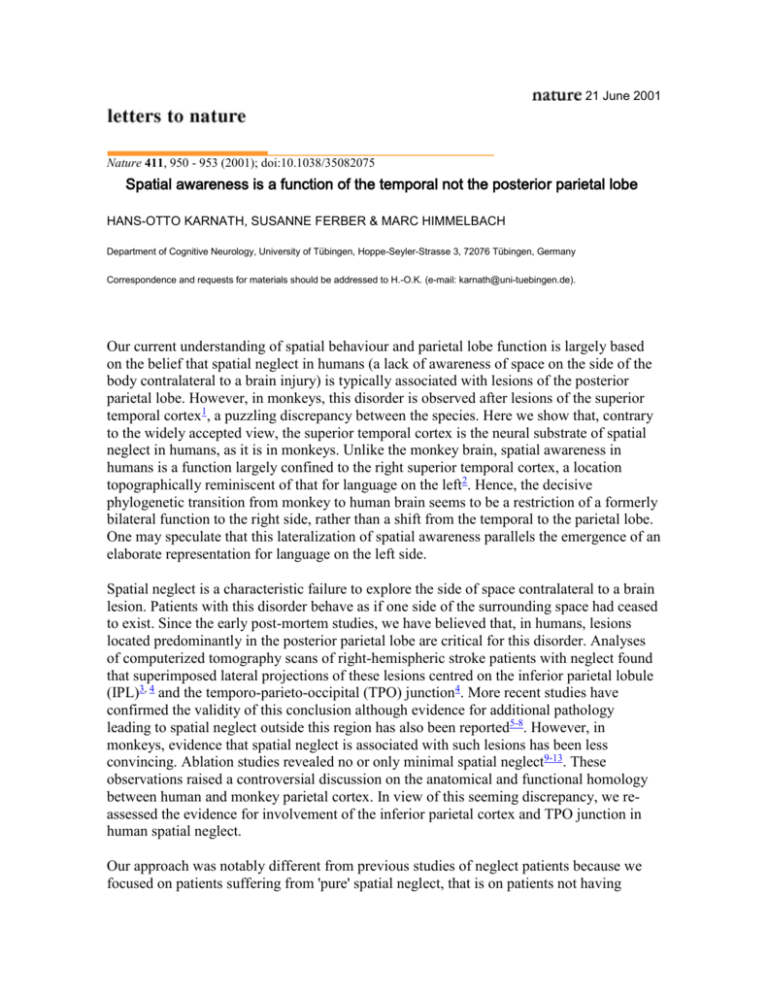
21 June 2001 Nature 411, 950 - 953 (2001); doi:10.1038/35082075 Spatial awareness is a function of the temporal not the posterior parietal lobe HANS-OTTO KARNATH, SUSANNE FERBER & MARC HIMMELBACH Department of Cognitive Neurology, University of Tübingen, Hoppe-Seyler-Strasse 3, 72076 Tübingen, Germany Correspondence and requests for materials should be addressed to H.-O.K. (e-mail: karnath@uni-tuebingen.de). Our current understanding of spatial behaviour and parietal lobe function is largely based on the belief that spatial neglect in humans (a lack of awareness of space on the side of the body contralateral to a brain injury) is typically associated with lesions of the posterior parietal lobe. However, in monkeys, this disorder is observed after lesions of the superior temporal cortex1, a puzzling discrepancy between the species. Here we show that, contrary to the widely accepted view, the superior temporal cortex is the neural substrate of spatial neglect in humans, as it is in monkeys. Unlike the monkey brain, spatial awareness in humans is a function largely confined to the right superior temporal cortex, a location topographically reminiscent of that for language on the left2. Hence, the decisive phylogenetic transition from monkey to human brain seems to be a restriction of a formerly bilateral function to the right side, rather than a shift from the temporal to the parietal lobe. One may speculate that this lateralization of spatial awareness parallels the emergence of an elaborate representation for language on the left side. Spatial neglect is a characteristic failure to explore the side of space contralateral to a brain lesion. Patients with this disorder behave as if one side of the surrounding space had ceased to exist. Since the early post-mortem studies, we have believed that, in humans, lesions located predominantly in the posterior parietal lobe are critical for this disorder. Analyses of computerized tomography scans of right-hemispheric stroke patients with neglect found that superimposed lateral projections of these lesions centred on the inferior parietal lobule (IPL)3, 4 and the temporo-parieto-occipital (TPO) junction4. More recent studies have confirmed the validity of this conclusion although evidence for additional pathology leading to spatial neglect outside this region has also been reported5-8. However, in monkeys, evidence that spatial neglect is associated with such lesions has been less convincing. Ablation studies revealed no or only minimal spatial neglect9-13. These observations raised a controversial discussion on the anatomical and functional homology between human and monkey parietal cortex. In view of this seeming discrepancy, we reassessed the evidence for involvement of the inferior parietal cortex and TPO junction in human spatial neglect. Our approach was notably different from previous studies of neglect patients because we focused on patients suffering from 'pure' spatial neglect, that is on patients not having additional primary defects in their visual field. This allowed us to study the neural correlate of pure spatial neglect without a bias to posterior visual regions inducing these latter defects. Forty-nine acute stroke patients with severe spatial neglect but no visual-field defects following circumscribed unilateral right-hemispheric brain lesions, consecutively admitted over a five-year period from a well defined recruitment area, were investigated. In 33 of these patients we found lesions affecting cortical areas, whereas lesions in the other 16 patients were confined to subcortical structures, namely the basal ganglia or the thalamus. Of the patients with cortical lesions, 25 (Table 1) showed no concurrent involvement of the basal ganglia or the thalamus; that is, they showed no involvement of those subcortical nuclei known to induce neglect independent of concomitant cortical damage3, 7, 14, 15. The superimposed lesion plots of these 25 subjects were compared with 25 right-brain-damaged (RBD) controls (Fig. 1) who likewise had no visual-field defects and cortical lesions without involvement of the basal ganglia or the thalamus. In clear contrast to controls, the lesion overlap in the neglect patients centred on the superior temporal gyrus (STG: Brodmann areas 22 and 42). Neighbouring structures affected were the ventral postcentral gyrus and the operculum. Interestingly, we found no evidence for a predominant involvement of the IPL3, 4, 6, 7, the TPO junction4, 7, 8, the cingulate cortex7, 8 or the middle temporal gyrus5 in patients with pure spatial neglect. This pattern did not change when we included the eight patients suffering from cortical lesions but with concurrent involvement of the basal ganglia or the thalamus. Figure 1 Lesion analysis of patients without (controls) and with spatial neglect. Full legend High resolution image and legend (116k) For statistical comparison of IPL with STG involvement, we defined the IPL and STG areas in Talairach space16 and determined (using MRIcro software17) to which percentage the individual lesion affected these two regions of interest (Fig. 1d). Between-group comparisons revealed a highly significant difference for the STG (Mann–Whitney U = 105, P < 0.001) showing that the area of the STG involved was 6.9 times larger in neglect patients (Fig. 1d). There was no such significant difference for the IPL (U = 301, P = 0.801). The comparison of relative involvement of the STG and the IPL within each group revealed a 3.7 times larger involvement of the STG in neglect patients (Wilcoxon Z = -3.51, P < 0.001). In controls, this comparison was not significantly different (Z = -1.07, P = 0.285). Table 2 in Supplementary Information gives coefficients for the correlation of IPL and STG involvement and the behavioural performance of the patients. The previous results on lesion location in neglect may have resulted from the inclusion of a significant proportion of patients who suffered not only from spatial neglect but also from additional visual-field defects. Hemianopia was present, for example, in 87% of the patients with spatial neglect studied by Vallar and Perani3 and in 50% of the patients investigated by Perenin6. Hence, it is plausible that in many cases lesions involved posterior visual regions, possibly confounding the interpretation of lesion location relevant to spatial neglect. To test this assumption, we studied 11 acute unilateral right-hemispheric stroke patients suffering from both severe spatial neglect and additional visual-field defects who were consecutively admitted over a 1.5-year period from the same recruitment area as for the groups above. Three of these patients showed concurrent involvement of the basal ganglia or thalamus and were not considered in the present analysis (Table 1). During the same period, we found four patients who suffered from an acute right-hemispheric stroke in the same vascular region as the neglect patients with visual-field defects and likewise exhibited visual-field defects but no spatial neglect (Table 1). If previous conclusions on lesion location in neglect were confounded by concomitant damage of visual cortical structures, the present comparison should reveal the following: (1) a clear difference in lesion location between those patients with pure neglect and those with both neglect and hemianopia (the latter involving also posterior regions); (2) those areas found as the neural correlate of spatial neglect in patients with pure neglect (Fig. 1) are affected in the patients suffering from both neglect and hemianopia; (3) the centre of lesion overlap in patients with neglect and hemianopia is comparable to that reported in earlier studies (that is, involves the IPL and TPO junction); and (4) the posterior parts of lesion overlap in the patients with neglect and hemianopia also overlap in those patients without neglect but with hemianopia due to a stroke in the territory of the same cerebral artery. Our data were in full accordance with these expectations. The centre of lesion overlap in the patients with both spatial neglect and visual-field defects involved the IPL and the TPO junction, which corresponds to earlier reports3, 4, 6-8 (Fig. 2, lower panel). However, the same region was also affected in the patients without neglect but with visualfield defects following a stroke in the territory of the middle cerebral artery (Fig. 2, upper panel). In both groups, visual-field defects were caused by lesion extension to the posterior horn of the lateral ventricle, thereby affecting the optic radiation. Figure 2 Lesion analysis of patients with visual-field defects (VFDs), without (RBD) and with spatial neglect. Full legend High resolution image and legend (61k) The present finding fits with observations of the consequences of experimental lesions in monkeys. Watson and co-workers1 found spatial neglect after ablation around both banks of the superior temporal sulcus. Although the focus found here in humans was on the superior temporal gyrus (STG), the observations correspond in that the superior temporal cortex rather than the IPL or the TPO junction is the substrate of spatial neglect in both monkeys and humans. The STG is located at the transition between the two major pathways of cortical visual processing, the 'what' and 'where' systems, respectively18. The STG is known to receive polysensory input from both streams thus representing a site of multimodal sensory convergence19-22. Our findings indicate that this information may serve as a matrix for spatial exploration and for spatial awareness. The results further indicate that the cytoarchitectonically identical areas 7 in the monkey and in the human are also functionally homologous. In monkeys, lesion of this area in either the right or the left hemisphere causes misreaching for objects with the contralesional arm but not spatial neglect1, 10, 11. The same is true for area-7 lesions in humans6. However, unlike area 7 in the parietal cortex, left- and right-hemisphere functions of the STG are different in monkeys and humans. Whereas loss of awareness of the contralesional side in monkeys is observed after lesions of this area in the left or right hemisphere1, 23, spatial neglect in humans is predominantly associated with right-hemispheric lesions24. The human superior temporal cortex in the opposite, left hemisphere subserves language functions2. Hence, the phylogenetic transition from the monkey to the human brain seems to be a restriction of a formerly bilateral function to the right side, rather than a shift from the temporal to the posterior parietal lobe. One may speculate that this lateralization of spatial awareness parallels the emergence of an elaborate representation of language on the left. However, in contrast to previous conviction, we suggest that parietal lobe organization (probably including human areas 39 and 40 (ref. 25) is in principle comparable and functionally homologous in both species, directly coding space for action. Methods Clinical investigation Patients were classified as having spatial neglect when they showed the typical clinical behaviour such as spontaneous deviation of the head and eyes toward the ipsilesional side, orienting towards the ipsilesional side when addressed from the front or the left, and ignoring contralesionally located people or objects. In addition, all patients were further assessed with the following four clinical neglect tests and had to fulfil the criterion in at least two of them. Letter cancellation test26: sixty target letters were distributed amid distractors on a horizontally oriented 21 29.7 cm sheet of paper, 30 within each half field. Patients had to cancel all target letters and were classified as suffering from spatial neglect when they omitted at least five left-sided targets. Bells test27: this consists of seven columns each containing five targets (bells) among distractors. Three of the seven columns (15 targets) are on the left side of a horizontally oriented 21 29.7 cm sheet of paper. More than five left-sided omissions indicated spatial neglect. Baking tray task28: patients had to place 16 identical items as evenly as possible on a blank test sheet (21 29.7 cm). Any distribution that is more skewed than seven items in the left half and nine on the right28 was considered a sign of neglect. Copying task: patients were asked to copy a complex multi-object scene consisting of four figures on a 21 29.7 cm sheet of paper. Omission of at least one of the left-sided features of each figure was scored as one and omission of each whole figure was scored as two. One additional point was given when left-sided figures were drawn on the right side. The maximum score was eight. A score higher than one, that is, more than 12.5% omissions, indicated neglect. All other relevant demographic and clinical parameters are shown in Table 1, together with an overview of these data. Visual-field defects were measured by Tübingen perimetry and standardized neurological examination. Lesion analysis Brain lesions were identified by computerized tomography or magnetic resonance imaging (MRI). Patients with diffuse or bilateral brain lesions, patients with tumours and patients in whom imaging revealed no manifest lesion were excluded. Lesions were mapped with MRIcro software17 (http://www.psychology.nottingham.ac.uk/staff/cr1/mricro.html). They were drawn manually on slices of a template MRI scan from the Montreal Neurological Institute (http://www.bic.mni.mcgill.ca/cgi/icbm_view), which is based on 27 T1-weighted MRI scans, normalized to Talairach space16. This scan was distributed with SPM99 (http://www.fil.ion.bpmf.ac.uk/spm/spm99.html). For superimposing of the individual brain lesions, the same MRIcro software17 was used. Three-dimensional rendering was carried out with mri3dX software (http://mrrc11.mrrc.liv.ac.uk/mri3dX). Supplementary information accompanies this paper. Received 23 January 2001; accepted 25 April 2001 References 1. Watson, R. T., Valenstein, E., Day, A. & Heilman, K. M. Posterior neocortical systems subserving awareness and neglect. Arch. Neurol. 51, 1014-1021 (1994). | PubMed | ISI | 2. Binder, J. The new neuroanatomy of speech perception. Brain 123, 2371-2372 (2000). | Article | PubMed | ISI | 3. Vallar, G. & Perani, D. The anatomy of unilateral neglect after right-hemisphere stroke lesions. A clinical/CT-scan correlation study in man. Neuropsychologia 24, 609-622 (1986). | Article | PubMed | ISI | 4. Heilman, K. M., Watson, R. T., Valenstein, E. & Damasio, A. R. in Localization in Neuropsychology (ed. Kertesz, A.) 471-492 (Academic, New York, 1983). 5. Samuelsson, H., Jensen, C., Ekholm, S., Naver, H. & Blomstrand, C. Anatomical and neurological correlates of acute and chronic visuospatial neglect following right hemisphere stroke. Cortex 33, 271-285 (1997). | PubMed | ISI | 6. Perenin, M. T. in Parietal Lobe Contributions to Orientation in 3D Space (eds Thier, P. & Karnath, H.-O.) 289-308 (Springer, Heidelberg, 1997). 7. Leibovitch, F. S. et al. Brain-behavior correlations in hemispatial neglect using CT and SPECT: the Sunnybrook Stroke Study. Neurology 50, 901-908 (1998). | PubMed | ISI | 8. Leibovitch, F. S. et al. Brain SPECT imaging and left hemispatial neglect covaried using partial least squares: the Sunnybrook Stroke Study. Hum. Brain Mapp. 7, 244-253 (1999). | Article | PubMed | ISI | 9. Ettlinger, G. & Kalsbeck, J. E. Changes in tactile discrimination and in visual reaching after successive and simultaneous bilateral posterior parietal ablations in the monkey. J. Neurol. Neurosurg. Psychiatry 25, 256-268 (1962). | ISI | 10. Lamotte, R. H. & Acuna, C. Deficits in accuracy of reaching after removal of posterior parietal cortex in monkeys. Brain Res. 139, 309-326 (1978). | PubMed | ISI | 11. Faugier-Grimaud, S., Frenois, C. & Stein, D. G. Effects of posterior parietal lesions on visually 12. 13. 14. 15. 16. 17. 18. 19. 20. 21. 22. 23. 24. 25. 26. 27. 28. guided behavior in monkeys. Neuropsychologia 16, 151-168 (1978). | Article | PubMed | ISI | Lynch, J. C. & McLaren, J. W. Deficits of visual attention and saccadic eye movments after lesions of parietooccipital cortex in monkeys. J. Neurophysiol. 61, 74-90 (1989). | PubMed | ISI | Gaffan, D. & Hornak, J. Visual neglect in the monkey. Representation and disconnection. Brain 120, 1647-1657 (1997). | Article | PubMed | ISI | Damasio, A. R., Damasio, H. & Chui, H. C. Neglect following damage to frontal lobe or basal ganglia. Neuropsychologia 18, 123-132 (1980). | Article | PubMed | ISI | Motomura, N. et al. Unilateral spatial neglect due to hemorrhage in the thalamic region. Acta Neurol. Scand. 74, 190-194 (1986). | PubMed | ISI | Talairach, J. & Tournoux, P. Co-planar Stereotaxic Atlas of the Human Brain: 3-Dimensional Proportional System--an Approach to Cerebral Imaging. (Thieme, New York, 1988). Rorden, C. & Brett, M. Stereotaxic display of brain lesions. Behav. Neurol. (in the press). Ungerleider, L. G. & Mishkin, M. in Analysis of Visual Behavior (eds Ingle, D. J., Goodale, M. A. & Mansfield, R. J. W.) 549-586 (MIT Press, Cambridge, Massachusetts, 1982). Jones, E. G. & Powell, T. P. S. An anatomical study of converging sensory pathways within the cerebral cortex of the monkey. Brain 93, 793-820 (1970). | PubMed | Seltzer, B. & Pandya, D. N. Afferent cortical connections and architectonics of the superior temporal sulcus and surrounding cortex in the rhesus monkey. Brain Res. 149, 1-24 (1978). | PubMed | ISI | Bruce, C., Desimone, R. & Gross, C. G. Visual properties of neurons in a polysensory area in superior temporal sulcus of the macaque. J. Neurophysiol. 46, 369-384 (1981). | PubMed | ISI | Felleman, D. J. & Van Essen, D. C. Distributed hierarchical processing in the primate cerebral cortex. Cereb. Cortex 1, 1-47 (1991). | PubMed | Luh, K. E., Butter, C. M. & Buchtel, H. A. Impairments in orienting to visual stimuli in monkeys following unilateral lesions of the superior sulcal polysensory cortex. Neuropsychologia 24, 461-470 (1986). | Article | PubMed | ISI | Mesulam, M.-M. Spatial attention and neglect: parietal, frontal and cingulate contributions to the mental representation and attentional targeting of salient extrapersonal events. Phil. Trans. R. Soc. Lond. B 354, 1325-1346 (1999). | Article | ISI | Darling, W. G., Rizzo, M. & Butler, A. J. Disordered sensorimotor transformations for reaching following posterior cortical lesions. Neuropsychologia 39, 237-254 (2001). | Article | PubMed | ISI | Weintraub, S. & Mesulam, M.-M. in Principles of Behavioral Neurology (ed. Mesulam, M.-M.) 71-123 (Davis, Philadelphia, 1985). Gauthier, L., Dehaut, F. & Joanette, Y. The bells test: a quantitative and qualitative test for visual neglect. Int. J. Clin. Neuropsychol. 11, 49-54 (1989). | ISI | Tham, K. & Tegnér, R. The baking tray task: a test of spatial neglect. Neuropsychol. Rehab. 6, 19-25 (1996). | ISI | Acknowledgements. This work was supported by grants from the Deutsche Forschungsgemeinschaft and the Bundesministerium für Bildung, Wissenschaft, Forschung und Technologie awarded to H.-O.K. We thank M. Niemeier, L. Johannsen and U. Zimmer for support with the neuropsychological testing of the patients; P. Thier for discussion and suggestions for the manuscript; U. Amann for help in the tomography archives; and C. Rorden for developing the MRIcro software.
